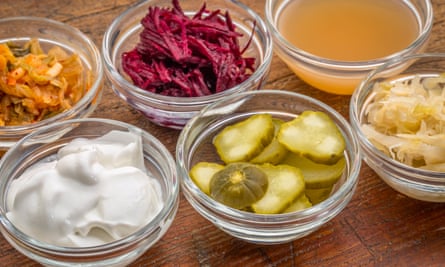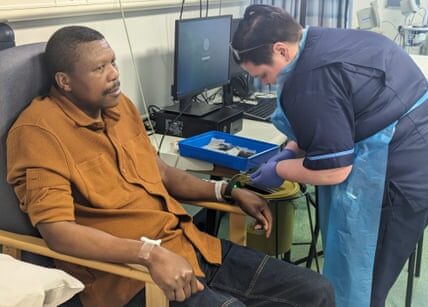We feel a strange sense of responsibility, in these microbiome-aware times, towards the bacteria, yeasts, fungi, viruses and protozoa living in and on us. While we can’t see our tiny brethren, research has revealed their fundamental role in keeping us healthy and happy. Genetically speaking, we are more microbe than human. Even if we only count the microbes that live on our skin, says Adam Friedman, a professor of dermatology at George Washington University’s School of Medicine and Health Sciences, “We have more bacterial genes than we do human genes. Together, we are a superorganism.”
It is nigh on catastrophic, then, that so many typical 21st-century western behaviours – poor diet, obsessing over hygiene, sedentary jobs – are bad for our microbes. But at least now that we know, we can act. We are nothing without our bugs, so here is how to nurture them.
Gut
“Pretty much everything can be linked back to the microbes in your gut,” says Orla O’Sullivan, a research fellow at Teagasc Food Research Centre and University College Cork. From hormone regulation to the immune system to our moods, “Keeping your gut microbes healthy is one of the most important things you can do for your health.”
If only it was as simple as identifying certain good microbes and swallowing lots of them, but it’s not. All we know is that diversity is key: “The more different types of microbe you have, the more functions they can perform,” O’Sullivan says. And when the diversity is out of whack – this is known as dysbiosis – pathogenic (disease-causing) germs can take hold.
A high-fibre diet is essential, with as many plant foods as possible, but this doesn’t mean you can’t ever get a takeaway. “A single bad meal isn’t going to undo your diet,” says O’Sullivan, “but your microbiome is pliable; you can change it. So by adopting a healthy eating plan, you can turn it around and make it healthy.”

Gut health experts bang on about fermented foods partly because they provide live, friendly microbes known as probiotics, although these won’t necessarily go forth and multiply in your gut. “They are more transient visitors, but they help to drive the overall diversity,” says O’Sullivan. It’s always best to make your own ferments like kefir, kimchi or sauerkraut, she says, “because you know how it’s been made and that it has live microbes in it.”
Fermented foods also provide prebiotics – microbe food – such as inulin. This is also found in foods such as chicory, onion, garlic and jerusalem artichokes.
Our microbes like us to keep fit, too. Scientists aren’t yet sure why, but again, it’s the long game that counts. “We’ve done studies where we put people on exercise programmes for around eight weeks and that doesn’t change our diversity,” says O’Sullivan. “You need to have chronic healthiness: long-term fitness, long-term healthy living is what’s important.”
Good sleep patterns have a positive effect, too. “If you’re sleeping well, you have less stress,” says O’Sullivan, and stress correlates with lower diversity. Plus, “if you’re tired, then you’re eating sugary foods,” and the high-fibre lifestyle goes out of the window.
If you nail diet and fitness, you shouldn’t need to take a probiotic supplement, unless you have had to take antibiotics (which kill friendly bugs along with the pathogens they target), “or if you’re in a bout of poor eating, like a stay in hospital, or if you’re travelling.” Make sure you get one of the established brands that have scientifically proven their bugs can survive our digestive juices and make it to the gut alive.
Skin
Friedman views the skin microbiota (which refers to the actual organisms, whereas the microbiome technically means their genetic makeup) as a living barrier. Again, diversity is what you want. “These microorganisms are involved in protecting us from potential pathogens, regulating our local immune system.”

Microbial colonisation of the skin starts when we are born, especially through vaginal delivery, and the microbiome evolves over time, but is easily disrupted in the modern world. Friedman uses a Petri dish metaphor: “If you were to scratch it all up, or put a whole bunch of toxic stuff on it, that would probably kill everything living on it.” Some of these exposures we can control – others, less so. “When we walk around, our skin is being assaulted by UV radiation, pollution, particulate matter,” he says. The fact that UV light is bad for bug diversity is another reason to use sunscreen.
Moisturising is good, too. Your average skin cream is, says Friedman, “fat, proteins and carbohydrates. They can serve as food to foster a healthy, diverse microbiota, and that’s where a lot of the work is being done. Several companies, like La Roche-Posay, Avène and Aveeno, are looking at a moisturiser as not just a sealant but as a ‘soil’ for the landscape.” Products are increasingly including prebiotics in formulations, “like selenium and various other things that can influence growth. Some of them have postbiotics also [things that bacteria make, or dead bacteria themselves], and if you apply them to someone who has, for example, eczema, which is the poster child for a skin disease that is driven by dysbiosis, simply restoring the diversity can improve outcomes.”
Things to avoid, he says, include toner, which is astringent, and is used to remove more oil from the skin. Traditional soap gets the thumbs down, too. It’s great at getting dirt off but along with it goes “all the wonderful fats and oils in our skin,” says Friedman. “They can tear apart the skin barrier. That’s part one. Part two is soap has a high pH, whereas our skin is acidic.” If the skin’s pH level rises too high, he says, “many good bacteria won’t survive.”
Some products protect skin pH levels with what dermatologists call buffering agents, colloidal oatmeal, for one: “It’s like your shield from the influence that could affect a change in the pH,” Friedman says. Instead of soap, use mild cleansers that are safe for sensitive and eczema-prone skin.
Friedman is “very much against physical exfoliation,” like body brushing or using a loofah. The skin barrier, he says, is essentially the outermost layer of the skin – the stratum corneum. It performs a lot of functions, “and while the skin cells are technically dead, it is home to the microbiota. They work together as a functional barrier.” Vigorously attacking that layer, he says, “is like tearing down the Amazon rainforest. It is physically injuring the skin. What I aim for is chemical exfoliation – using things like alpha and beta hydroxy acids that will break down the stratum corneum if there’s too much of it, to help things keep turning over.” In fact, some of our bacteria naturally create these acids. “I think that that’s a much safer approach than loofahs and brushes.”
Mouth and nose
According to the recent flurry of research into the microbes of the upper respiratory tract, says Christina Kumpitsch, microbiologist at the Medical University of Graz in Austria, “Numerous behaviours can impact the microbiome within these areas.” Smoking is the first on her hit list. Cigarette smoke, “directly affects microbes through mechanisms like oxygen deprivation, or by disrupting defence mechanisms against pathogens, such as mucociliary clearance,” which is where nasties are carried off by mucus pushed along by cilia, the tiny hair-like structures on the surface of cells.

Pollution is, unsurprisingly, not good for the nasal flora: “Inflammation and immune responses triggered by air pollutants can alter the nasal cavity environment, leading to changes in conditions favouring the increase of pathogens,” says Kumpitsch. “Particularly with chronic exposure.”
This is an area where fastidious hygiene pays off. That plaque that can accumulate in the mouth, she says, “is comprised of microbial biofilms, [germ colonies] fostering the growth of harmful microbes and contributing to conditions such as gum diseases.” This is why regular dental checkups are important: “Early detection and treatment of conditions such as dental decay, gum disease, sinusitis and allergies could help preserve the health of the oral and nasal microbial communities.” But back away from the mouthwash, which won’t select between good or bad microbes, “and can reduce the overall microbial diversity in the oral cavity.” It’s even being posited, she says, “that overuse of certain antiseptic mouthwashes may contribute to bacterial resistance.”
Watch out for open-mouth breathing because acid-producing bacteria thrive in a dry mouth and all that acid can contribute to enamel erosion and tooth decay. Typically, she says, “saliva buffers acids and provides antimicrobial properties to control harmful bacteria.” Similarly, drinking alcohol diminishes saliva and dries the mouth, while eating lots of sugary treats feeds the acid-depositing microbes.
Antibiotics will affect the area’s diversity, but so too can corticosteroid nasal sprays, commonly used for allergic rhinitis, dampening the goodies while promoting the baddies. Nasal rinses, she says, “offer a microbiome-friendly alternative, aiding the removal of allergens, pollutants or inflammation factors which would otherwise lead to a microbial shift associated with disease.” The most common, she says, are “isotonic saline (0.9%) or hypertonic saline (1.5-3%), with a pH varying from 4.5 to 7,” but distilled water is also good. (Avoid tap water, which is more likely to pose an infection risk.) In addition, she says that probiotics specifically designed for nasal use can promote nasal health. For mouths, eating all the probiotic foods recommended for guts can also support the oral microbiome.
Genital and urinary

Women tend to get more urinary tract problems than men, partly because when pathogenic germs sneak from the bottom to the genital area, they have a shorter journey up the urinary tract to cause infection and inflammation. Which is why a healthy balance of microbes in and around the vagina to see them off is crucial. But maintaining this balance becomes harder in the menopausal years. Up until then, the good lactobacillus thrive more easily, says Ciara Kenneally, PhD researcher at Munster Technological University.
This is because oestrogen “helps produce the compound glycogen, which the lactobacillus essentially feeds on”. So for the many women who develop recurrent urinary tract infections at this stage in life, she says, “it’s very important, especially for postmenopausal women, to take some sort of hormone replacement therapy like vaginal oestrogen as a preventive.”
UTIs don’t typically trouble men as much until they are older and using catheters, upon which, says Kenneally, “masses of bacteria can grow”. In fact, this is one of the few areas of medical research in which less has been done on men than on women. Unlike women’s genitals, the outside of the penis, she says, “is more similar to the skin microbiome and consequently, there’s a huge difference between the male and female urinary microbiomes”.
A heathy gut microbiome will affect the upper end of the urinary system and bladder. But there are other lifestyle factors that can affect the genital microbiota.
“Using contraception that has spermicide,” says Kenneally, “can really alter your microbiome and cause dysbiosis like thrush or bacterial vaginosis.”
“Be careful with antibiotics,” she warns. “If you take a course for a UTI and don’t finish it, the bacteria that caused it [most commonly E coli] might go dormant and slowly build up and after three months your infection might come back and you have a cycle of a recurrent infection.”
Douching is not recommended. “It really can be harmful to your microbiome. The vaginal tract is self-cleaning, so what is recommended is to use a gentle, non-scented soap just on the outside.”
Period products can have a massive influence, too. “Tampons and sanitary pads are laced with different toxins, unlike menstrual cups.” Plus, merely sitting on a warm, damp pad for hours at a time can cause problems, says Kenneally. “There is recent research proving that with a menstrual cup, the microbiome stays more stable, whereas using a tampon or pads can alter it.”
Source: theguardian.com



